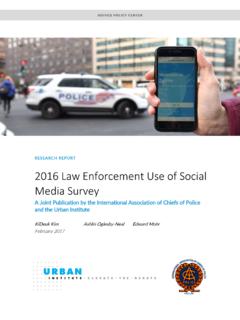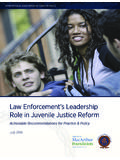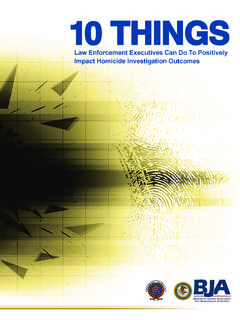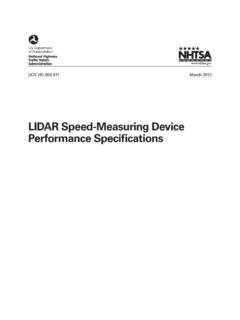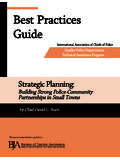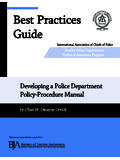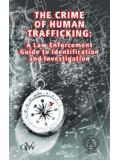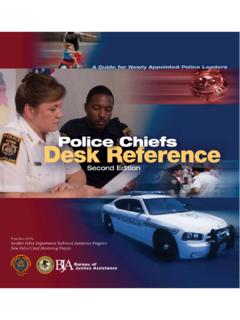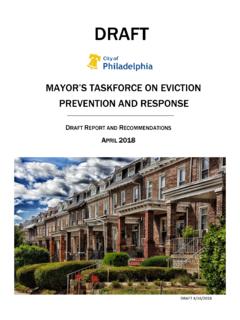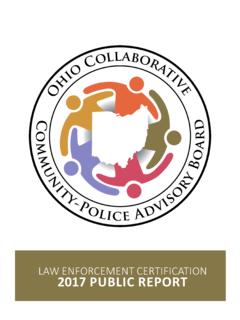Transcription of An Evidence-Assessment of the …
1 An Evidence-Assessment of the recommendations . of the PRESIDENT'S TASK force . on 21st Century Policing Implementation and Research Priorities An Evidence-Assessment of the recommendations of the President's Task force on 21st Century Policing . Implementation and Research Priorities This report is a reference document for the Blueprint for 21st Century Policing, which is funded by the Laura and John Arnold Foundation and is a project of the Institute for Community-Police Relations of the International Association of Chiefs of Police. Questions regarding the Institute for Community-Police Relations and the Blueprint for 21st Century Policing: Jim Baker, Director of Advocacy International Association of Chiefs of Police 44 Canal Center Plaza, Suite 200. Alexandria, VA 22314. Email: Phone: 800-THE-IACP. Questions regarding this research report : Drs.
2 Cynthia Lum and Christopher Koper, Principal Investigators Center for evidence -Based Crime Policy Department of Criminology, Law and Society George Mason University 4400 University Drive, MS 6D12. Fairfax, VA 22030. Email: Phone: 703-993-3421. Citation for this report : Lum, C., Koper, , Gill, C., Hibdon, J., Telep, C. & Robinson, L. (2016). An evidence - assessment of the recommendations of the President's Task force on 21st Century Policing . Implementation and Research Priorities. Fairfax, VA: Center for evidence -Based Crime Policy, George Mason University. Alexandria, VA: International Association of Chiefs of Police. Special thanks: The research team would like to thank Amber Scherer, Bill Johnson, and Xiaoyun Wu for their editorial and research assistance on this project. Disclaimer: Views expressed herein are those of the author(s) and do not necessarily represent those of the funding organization, the Laura and John Arnold Foundation.
3 TABLE OF CONTENTS. TABLE OF ABOUT THIS RESEARCH HOW TO USE THIS PILLAR 1: BUILDING TRUST AND SUMMARY OF PILLAR 1 RESEARCH ON THE recommendations AND THEIR PRIORITIZING ACTION BASED ON THE RESEARCH RESEARCH PILLAR 2: POLICY AND SUMMARY OF PILLAR 2 RESEARCH ON THE recommendations AND THEIR PRIORITIZING ACTION BASED ON THE RESEARCH RESEARCH PILLAR 3: TECHNOLOGY AND SOCIAL SUMMARY OF PILLAR 3 RESEARCH ON THE recommendations AND THEIR PRIORITIZING ACTION BASED ON THE RESEARCH RESEARCH PILLAR 4: COMMUNITY POLICING AND CRIME 28. SUMMARY OF PILLAR 4 RESEARCH ON THE recommendations AND THEIR PRIORITIZING ACTION BASED ON THE RESEARCH RESEARCH PILLAR 5: TRAINING AND 34. SUMMARY OF PILLAR 5 34. RESEARCH ON THE recommendations AND THEIR 34. PRIORITIZING ACTION BASED ON THE RESEARCH RESEARCH PILLAR 6: OFFICER WELLNESS AND 39.
4 SUMMARY OF PILLAR 6 RESEARCH ON THE recommendations AND THEIR PRIORITIZING ACTION BASED ON THE RESEARCH RESEARCH 43. 44. 2 AN Evidence-Assessment OF THE recommendations OF THE PRESIDENT'S TASK force ON 21ST CENTURY POLICING. ABOUT THIS RESEARCH report . T. he final report of the President's Task force on 21st Century Policing1 is one of the most significant documents for law enforcement in modern history. The Task force was charged by President Obama in 20142 to examine ways of fostering strong, collaborative relationships between local law enforcement and the communities they protect and to make recommendations to the President on the ways policing practices can promote effective crime reduction while building public trust ( final report , p. 5). Within six pillars building trust and legitimacy, policy and oversight, technology and social media, community policing and crime reduction, training and education, and officer wellness and safety the Task force presented 156 recommendations and action items to law enforcement agencies and the federal government with the goal of strengthening democratic policing in a complex and diverse society.
5 Of these 156 recommendations , approximately 63 were directed toward federal agency implementation, while 87 were relevant for state and local law enforcement agencies. Another six recommendations and action items were relevant to both the federal government and to state and local agencies. Where should law enforcement agencies begin in implementing these recommendations ? Which recommendations should be prioritized for action, for policy implementation, or for more research? With a grant from the Laura and John Arnold Foundation, the Institute for Community-Police Relations of the International Association of Chiefs of Police (IACP)3 has collaborated with researchers from George Mason University's (GMU) Center for evidence -Based Crime Policy4 to create an evidence -based Blueprint for 21st Century Policing.
6 The research team was charged with reviewing existing research knowledge about those Task force recommendations relevant to state and local law enforcement, highlighting promising efforts based on research knowledge, and identifying issues that need more research and testing. Including research in the conversation about law enforcement policy and practice an idea known as evidence -based policing has become an important value of law enforcement. evidence -based policing is based on the idea that research knowledge is an essential part of police decision-making and can provide expertise and an objective perspective for a complex profession. Toward those ends, the goal of this assessment of the research knowledge behind the Task force recommendations is to provide information about what we know from research about those recommendations and what more needs to be learned through police-research partnerships to advance them.
7 1 The President's Task force on 21st Century Policing, final report of the President's Task force on 21st Century Policing (Washington, : Office for Community Oriented Policing Services, 2015), pdf/ 2 See Exec. Order No. 13684, 79 Fed. Reg. 76865 (Dec. 18, 2014), office/2014/12/18/executive-order-establ ishment-presidents-task- force -21st-centu ry-policin. 3 See IACP, Institute for Community Police Relations, 4 See George Mason University (GMU), Center for evidence -Based Crime Policing (CEBCP), 3 AN Evidence-Assessment OF THE recommendations OF THE PRESIDENT'S TASK force ON 21ST CENTURY POLICING. HOW TO USE THIS report . This report should be used as a research reference for the IACP's Blueprint for 21st Century Policing (see ). Law enforcement agencies seeking guidance on implementing the President's Task force recommendations should begin with the Blueprint interactive website and report , which condenses and references the research findings provided in this research reference.
8 For each pillar of the President's Task force report , we present four sections: 1. A bulleted summary of the Task force recommendations most relevant to local law enforcement. (Readers should refer to the original Task force recommendations if they need exact wording of each recommendation and action item.). 2. An evidence assessment of those recommendations , which describes what we know from research about the recommendations . We also include in this section any guidance that research has provided with regard to the effective implementation of the Task force recommendations . 3. Conclusions, based on the evidence assessment , about which recommendations might be prioritized for action. This is useful for agencies that wish to structure their implementation of the Task force recommendations from an evidence -based perspective.
9 4. Identified research opportunities based on the evidence assessment . For researchers and those funding research, we highlight a number of questions raised by the Task force recommendations that remain under-researched and that need more rigorous study and funding. We recognize that agencies have different priorities and values with regard to which of the Task force recommendations to implement. Our efforts in this report are meant to provide an evidence -based perspective and structure in implementing the Task force recommendations . 4 AN Evidence-Assessment OF THE recommendations OF THE PRESIDENT'S TASK force ON 21ST CENTURY POLICING. PILLAR 1: BUILDING TRUST AND LEGITIMACY. SUMMARY OF PILLAR 1 recommendations . Many of the recommendations in Pillar 1 focus on procedural justice and the link between procedural justice and legitimacy and trust in the community.
10 This is guided by the work of Tom Tyler and colleagues. Tyler (1990, 2004) argues that when police (or other authority figures) treat citizens in procedurally just ways ( , by giving them a voice, by acting neutral, by treating them with dignity and respect, and by making it clear their motives can be trusted), citizens are more likely to view police as legitimate. In turn, this increased legitimacy should also increase citizen compliance with both police directives and the law. Thus, this argument has significant implications for both legitimacy building and potentially reducing crime in the long term (see Mazerolle, Bennett, Davis, et al., 2013). The key themes of this pillar's recommendations are Procedural justice should be the guiding principle for both citizen-police interactions as well as for internal policies and practices in police agencies ( , involving employees in organizational change and revisions to disciplinary procedures).
